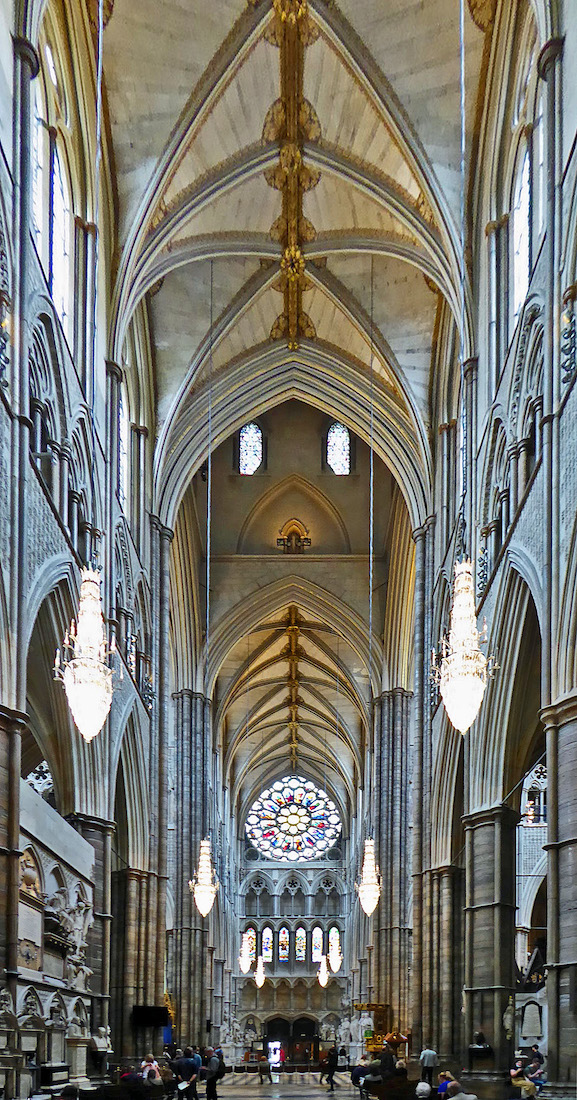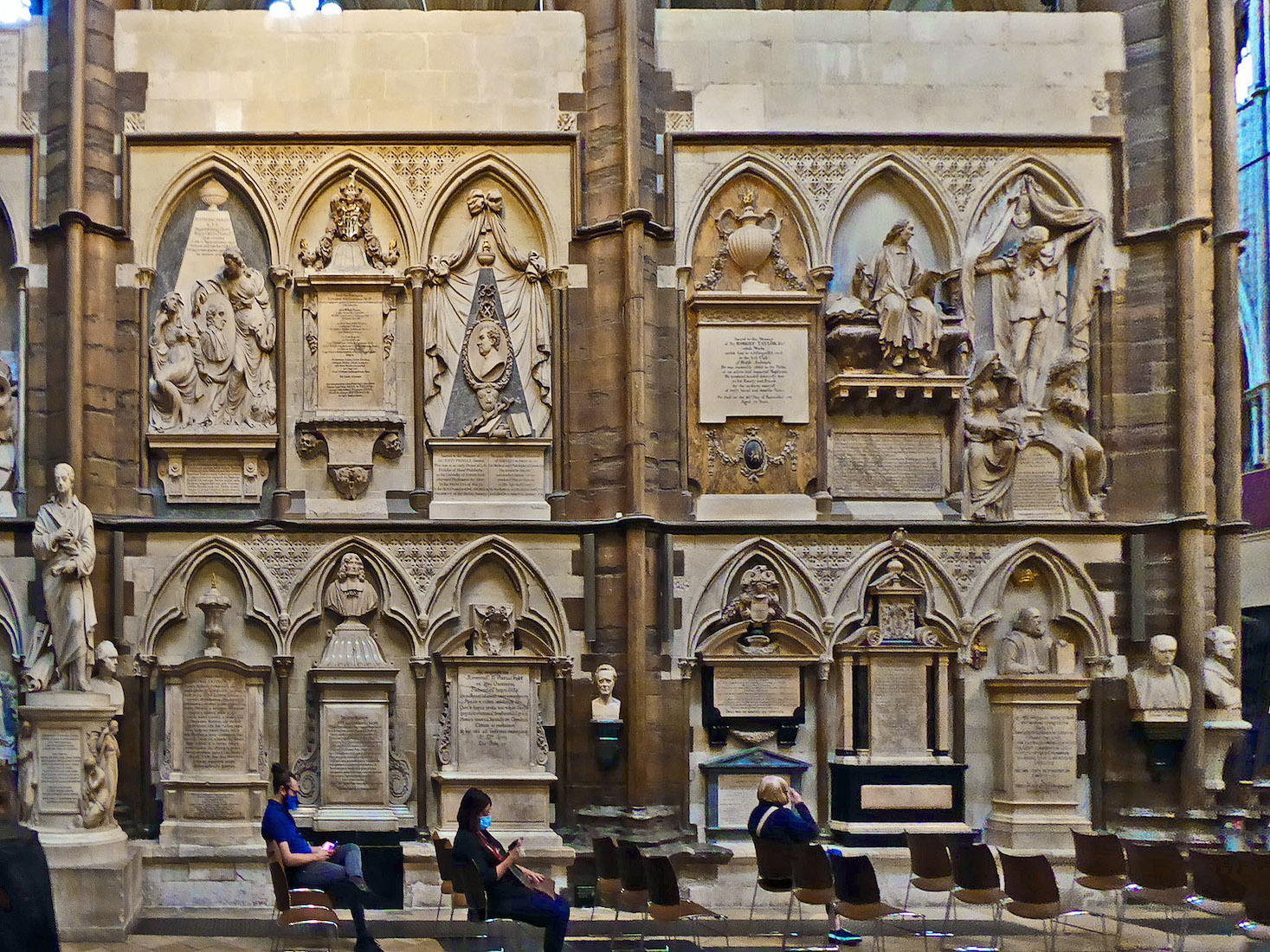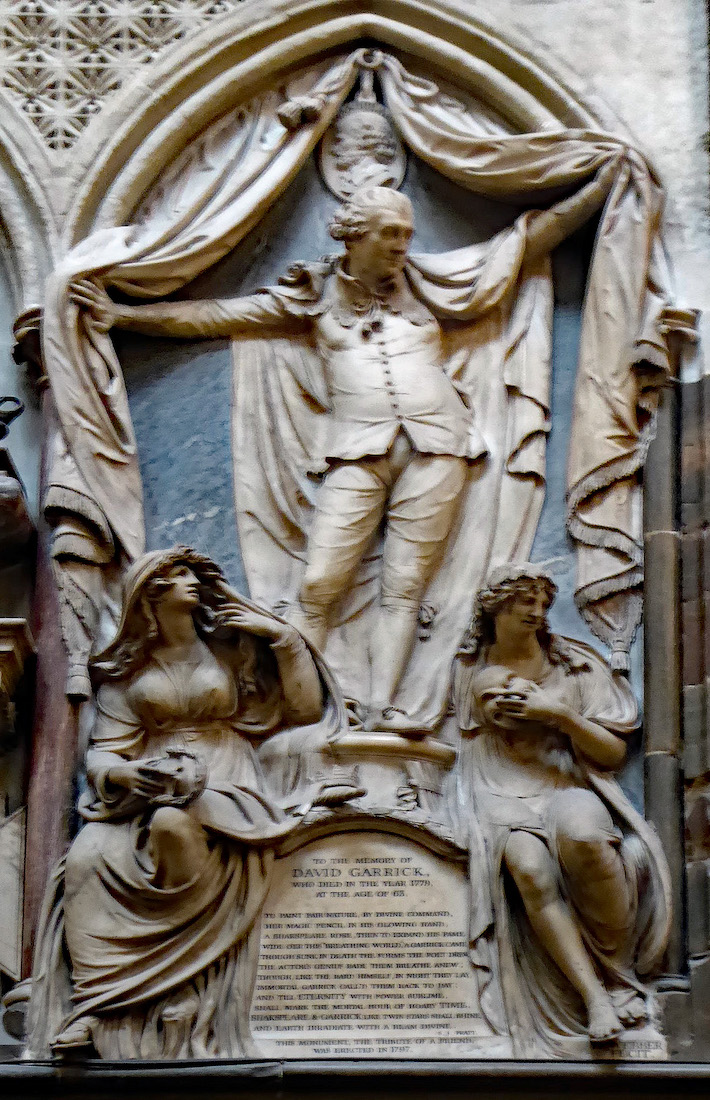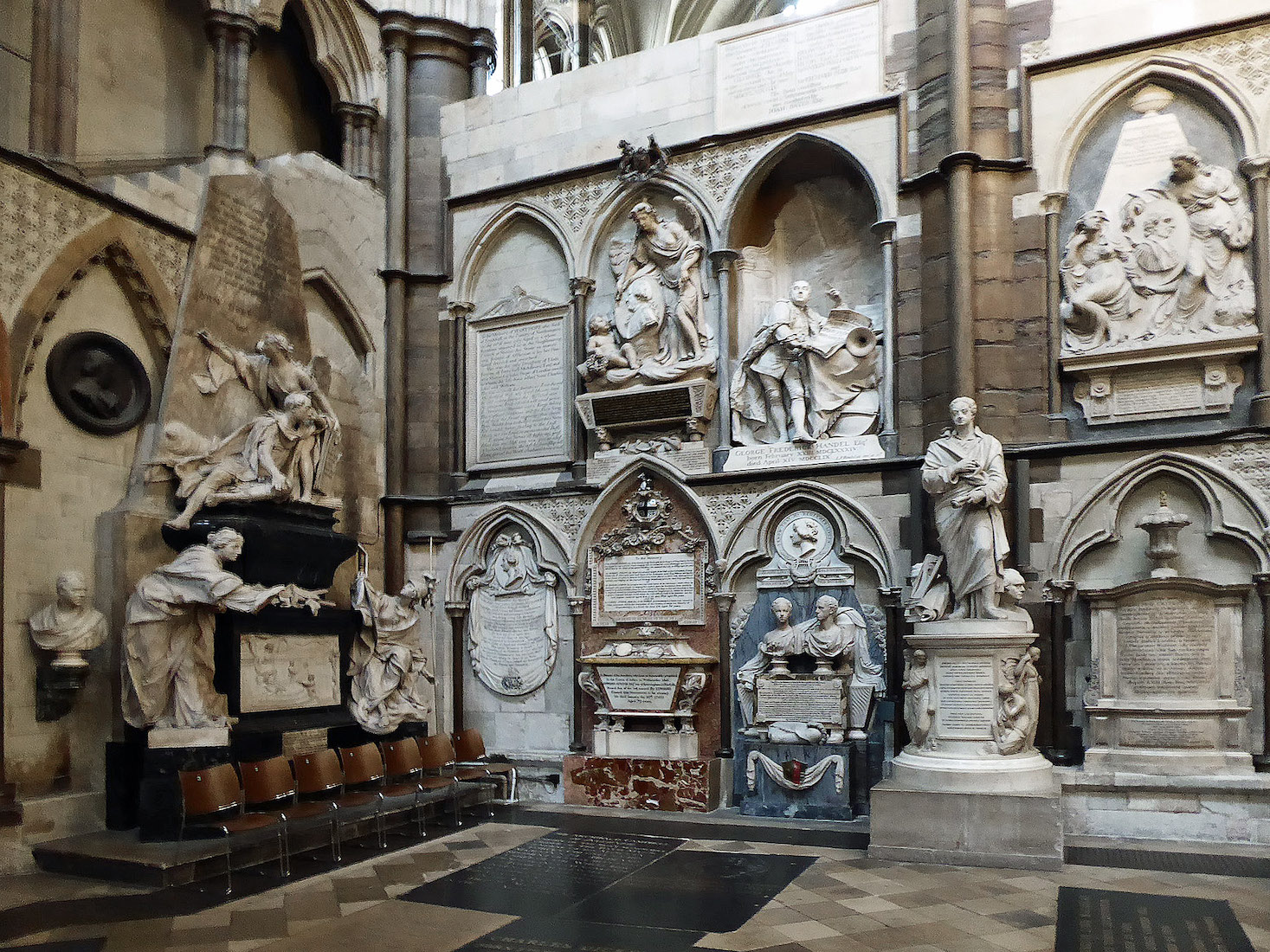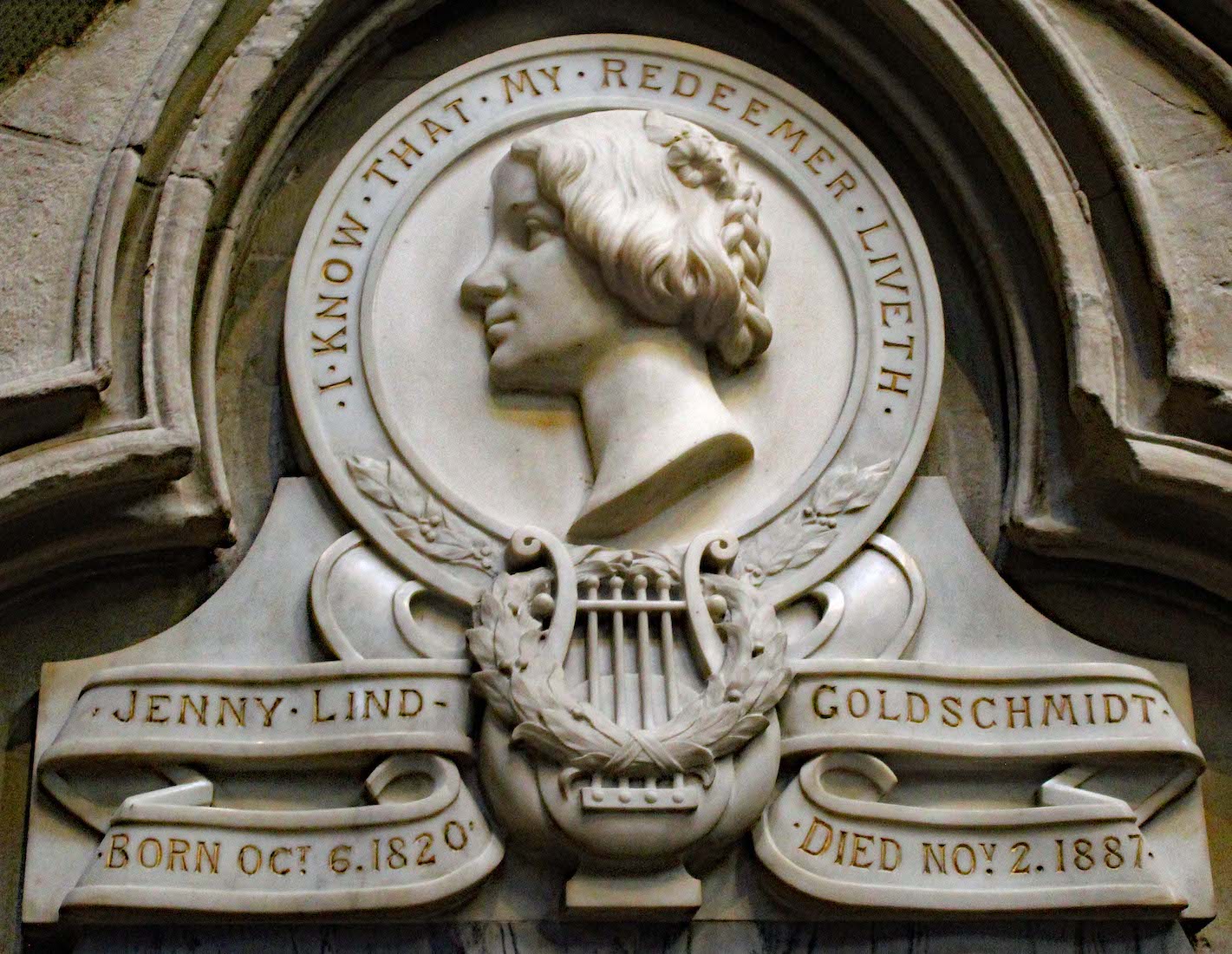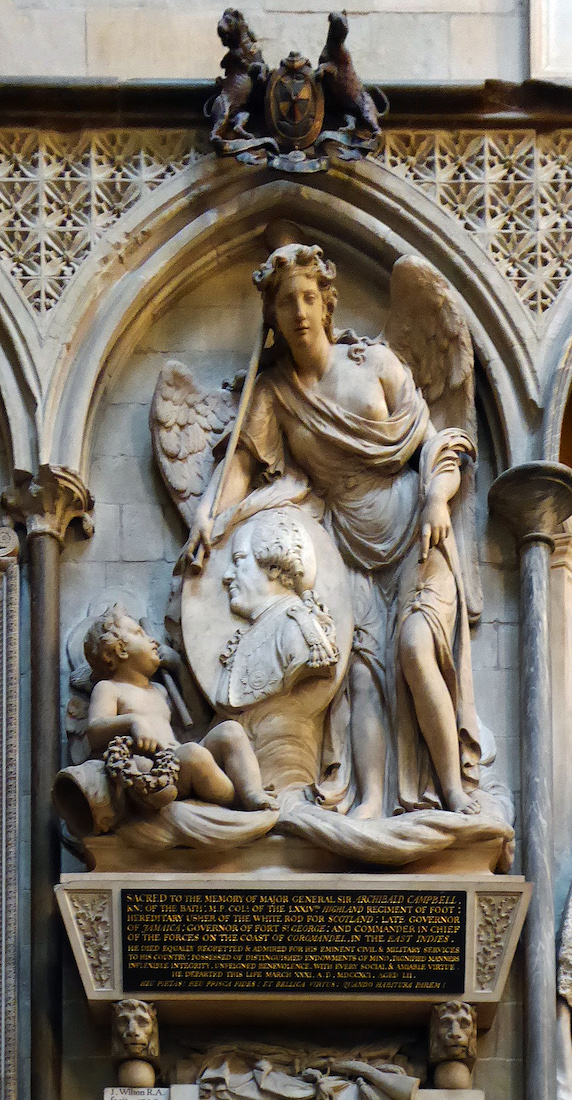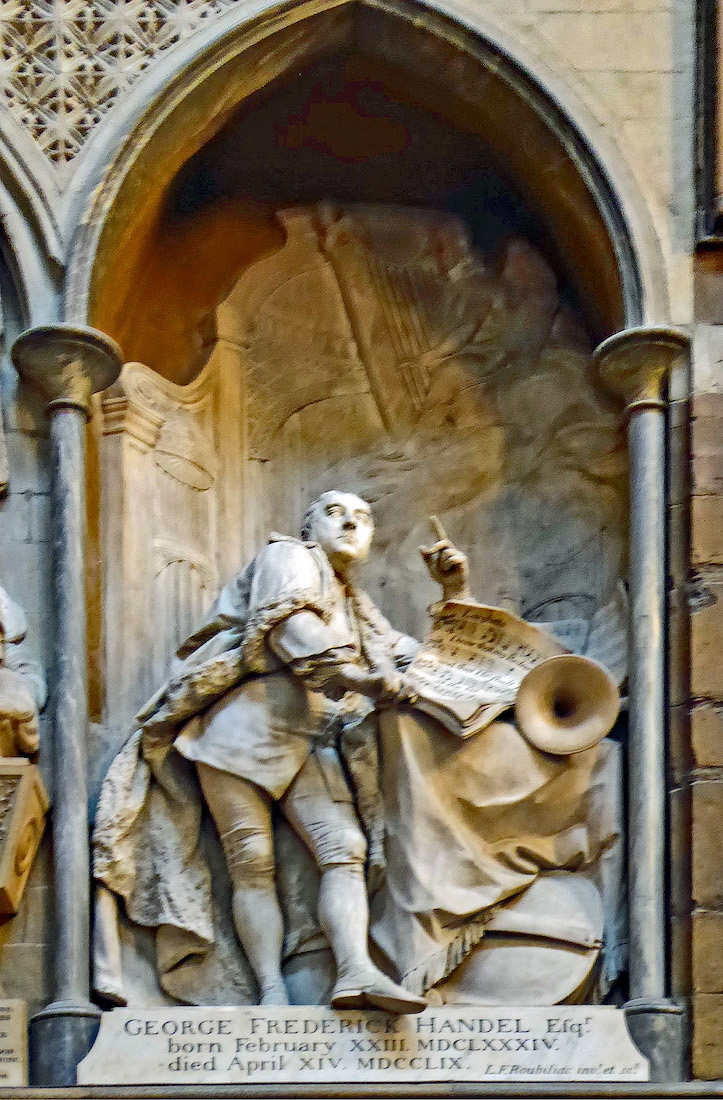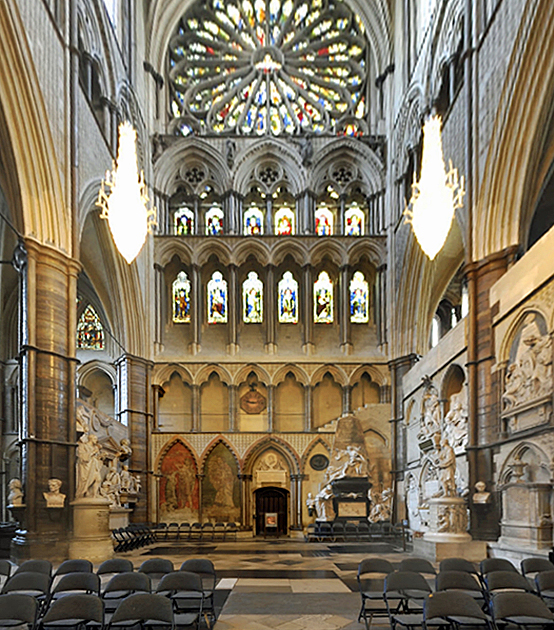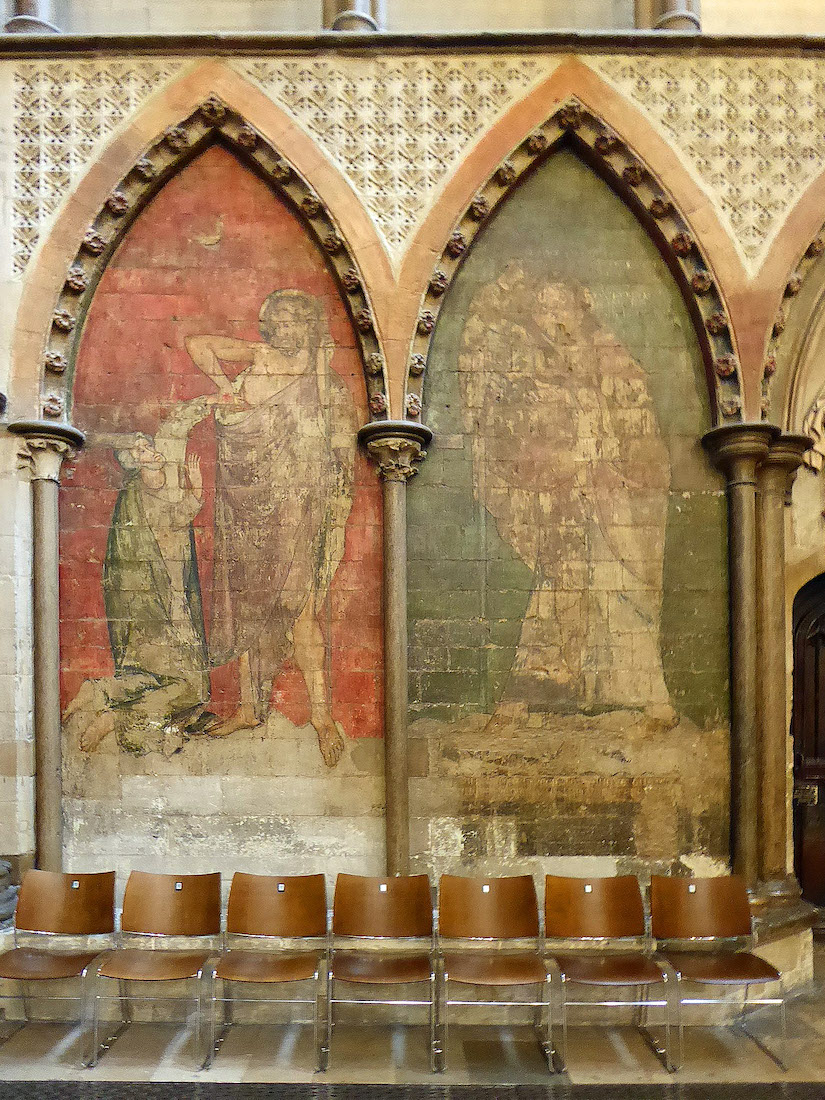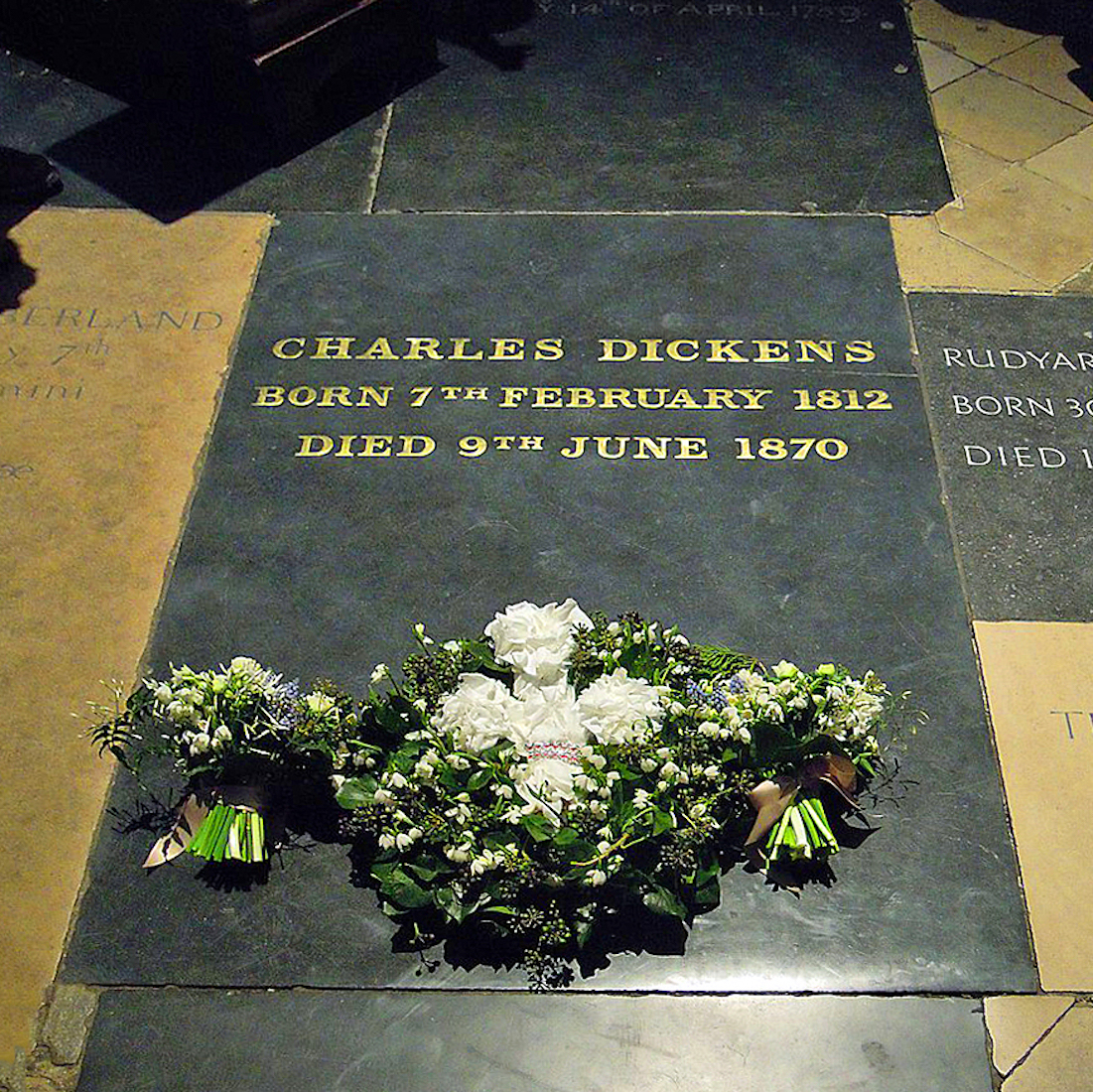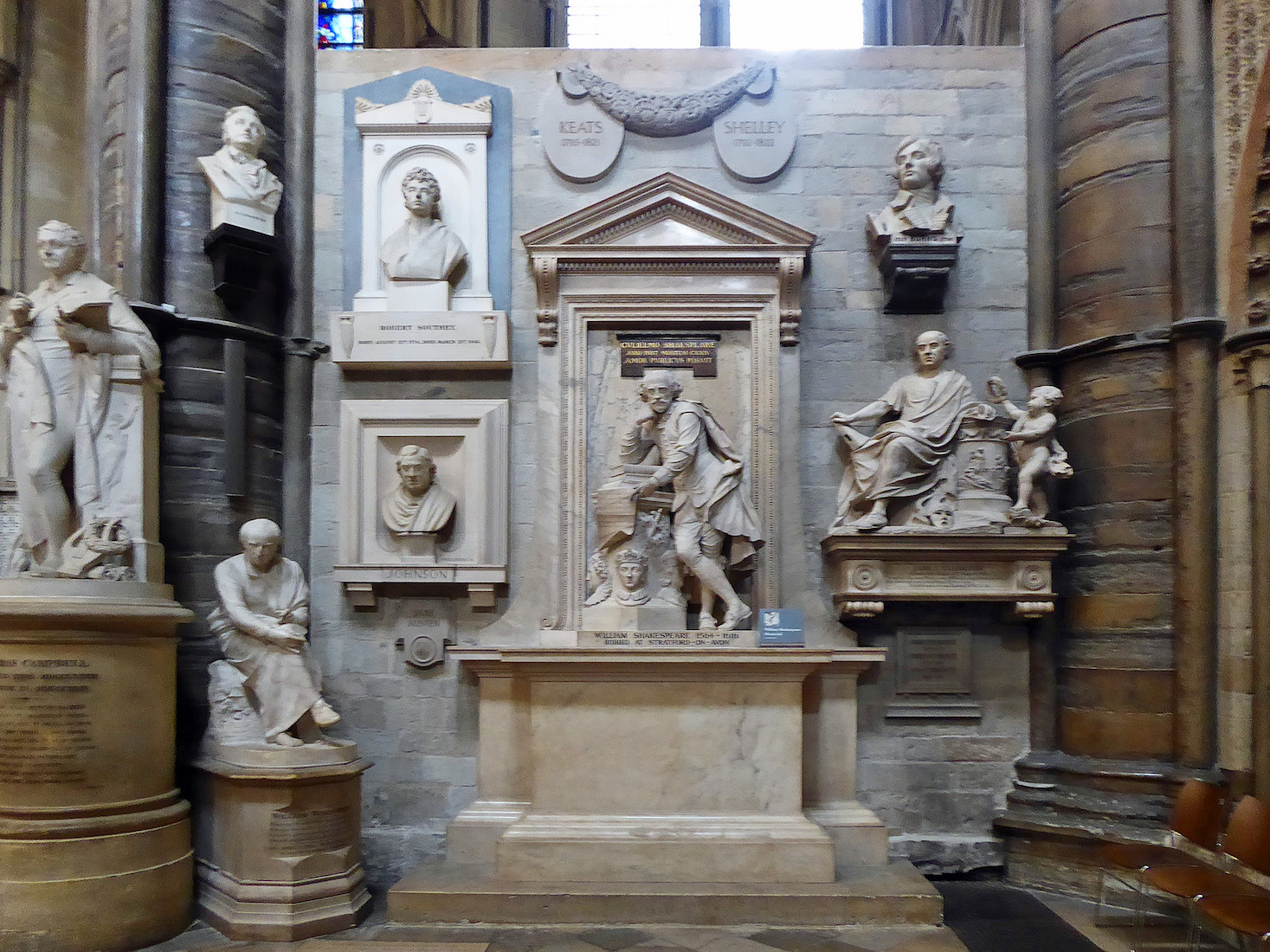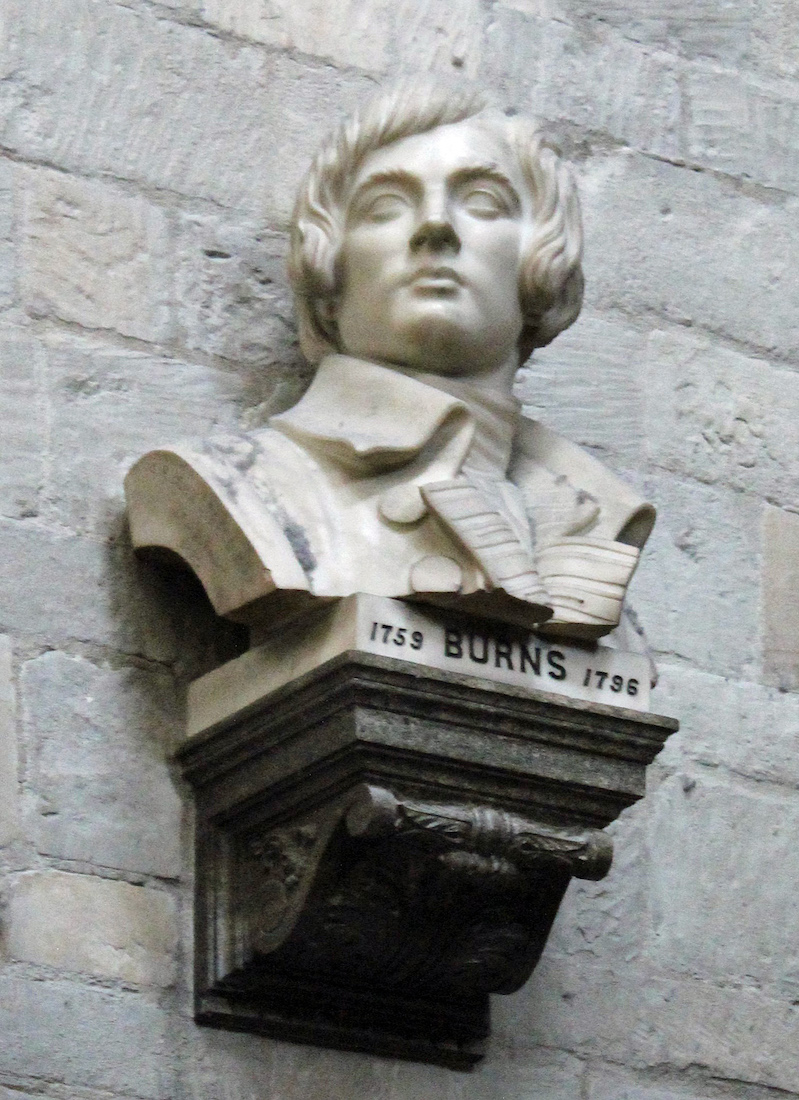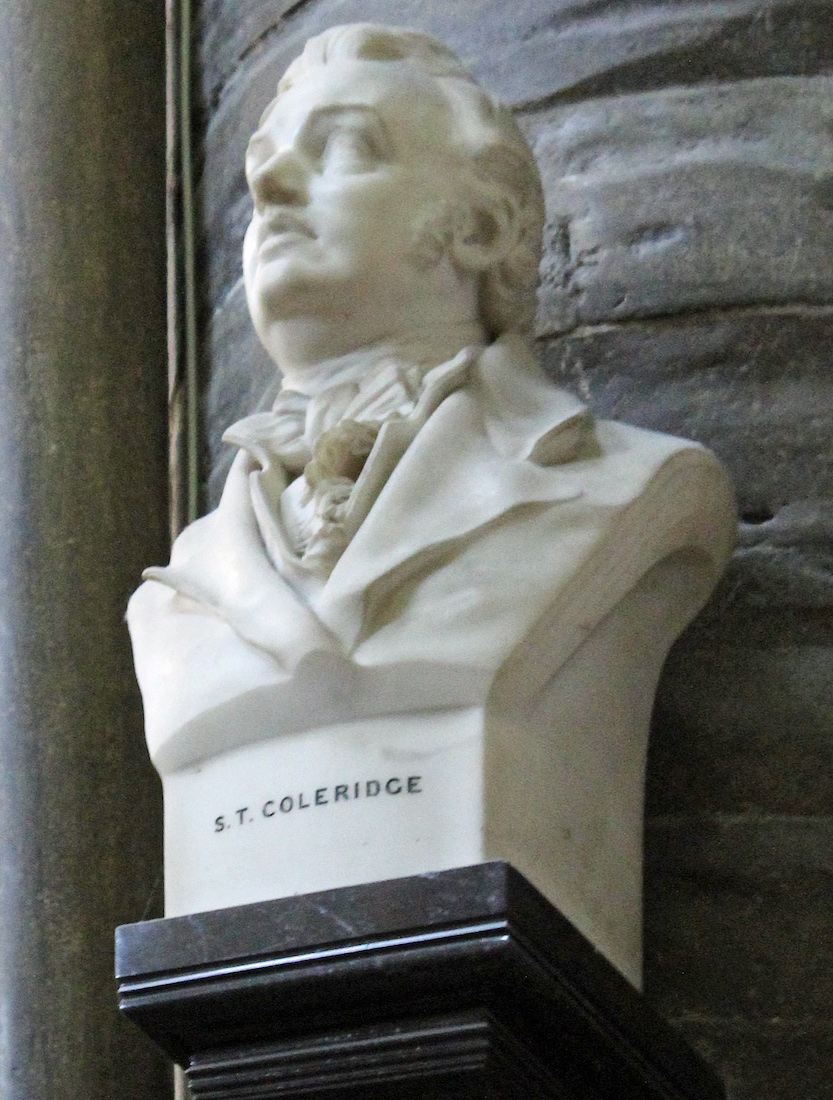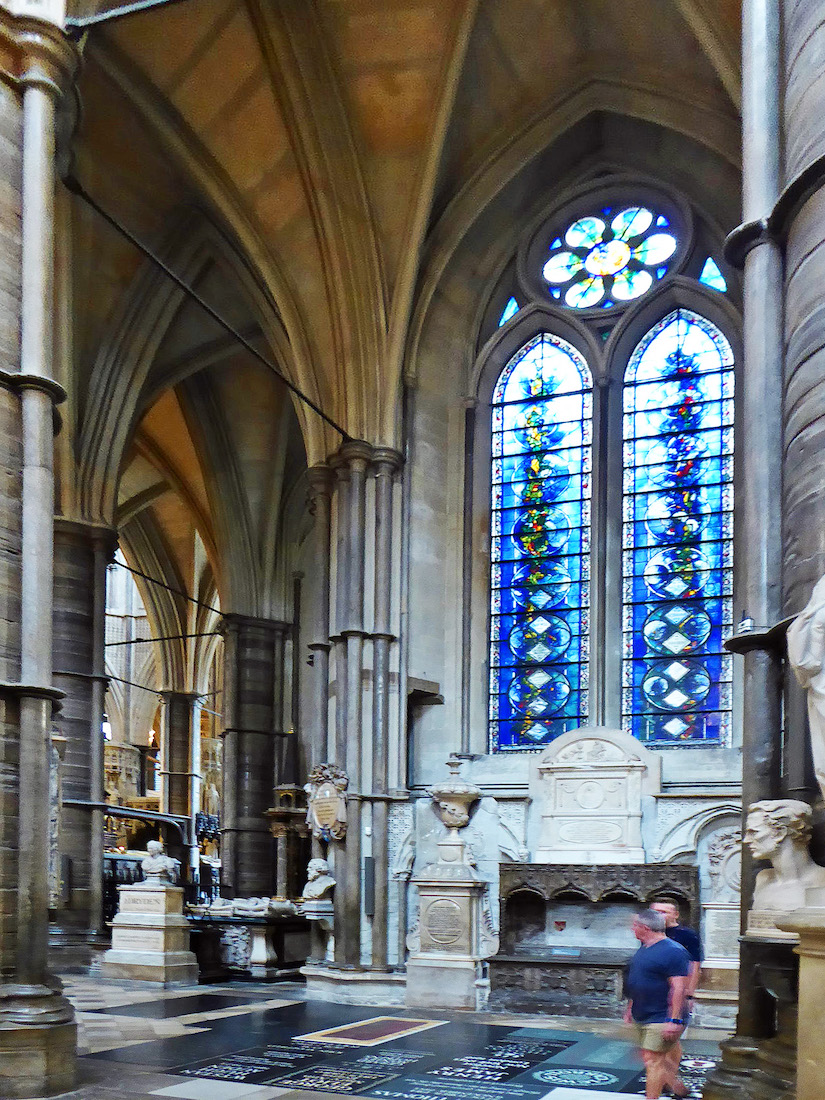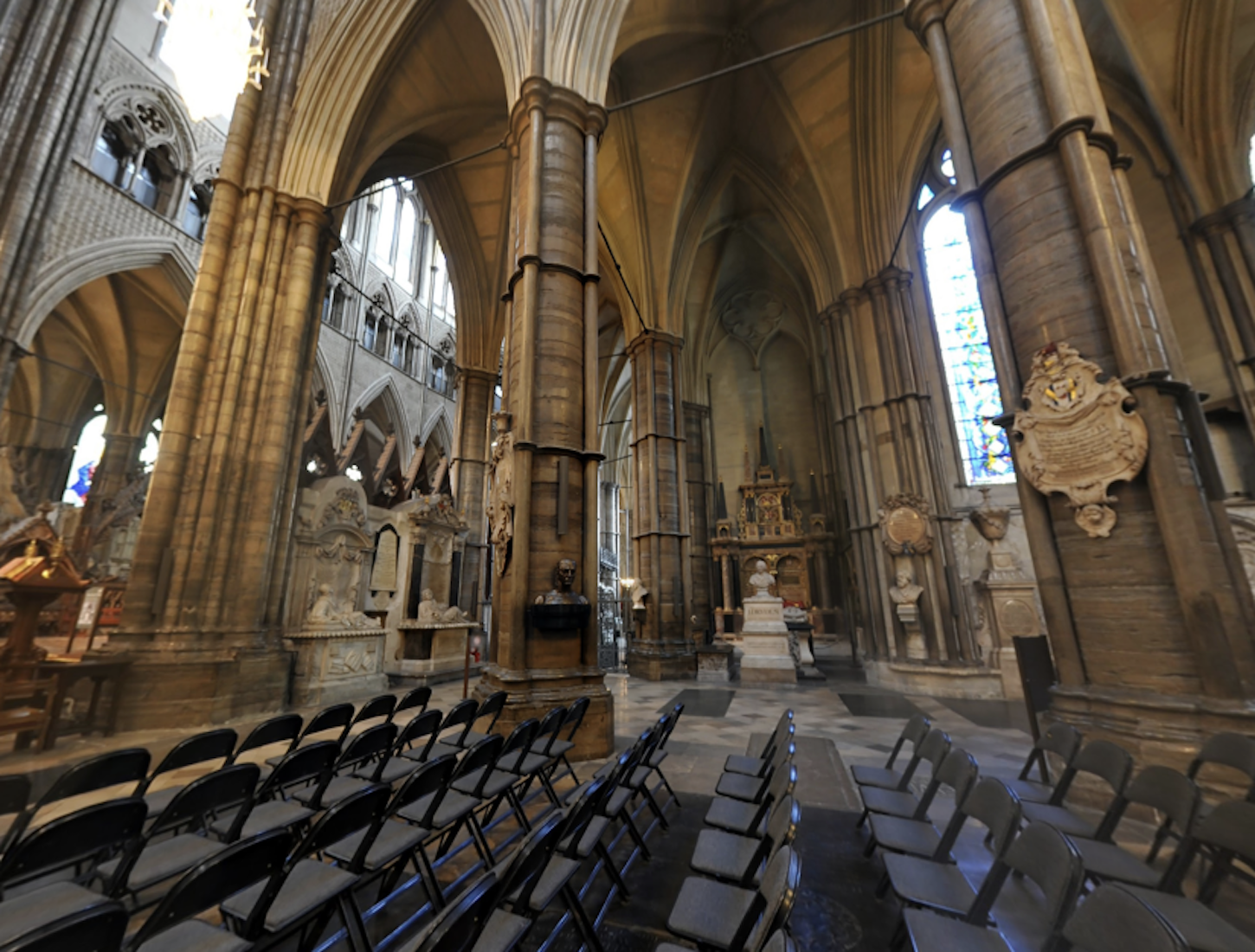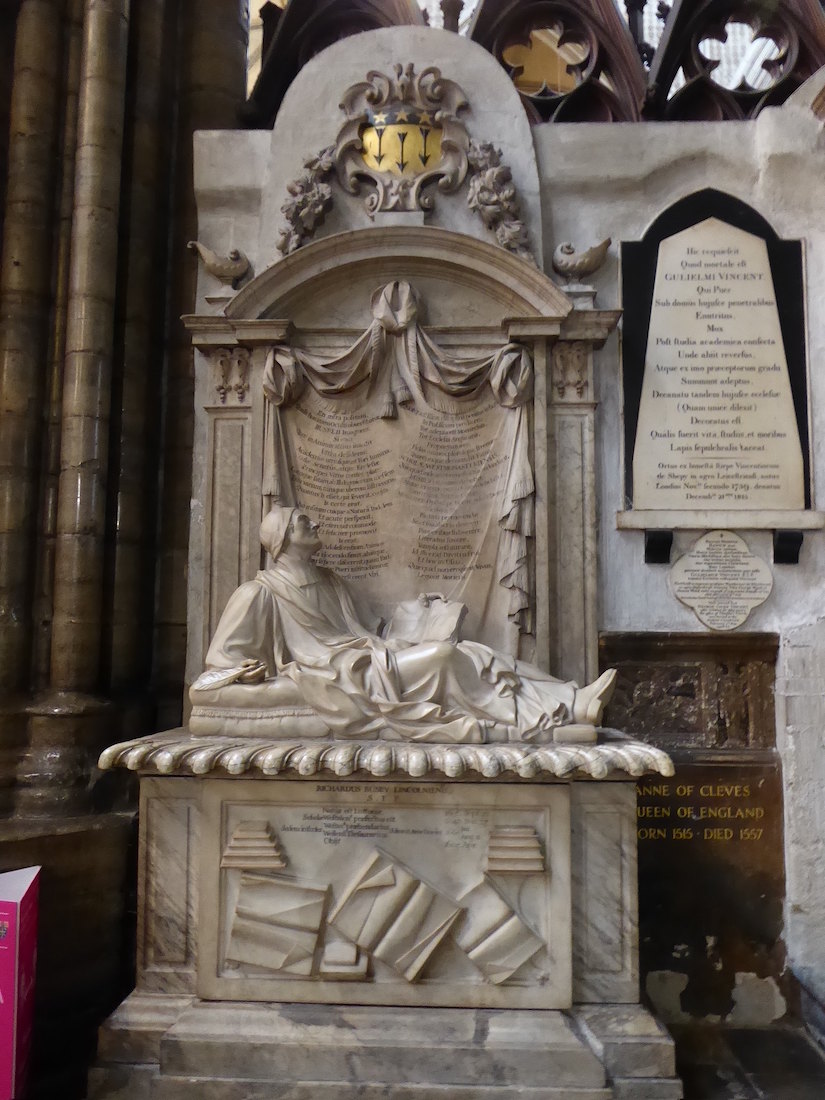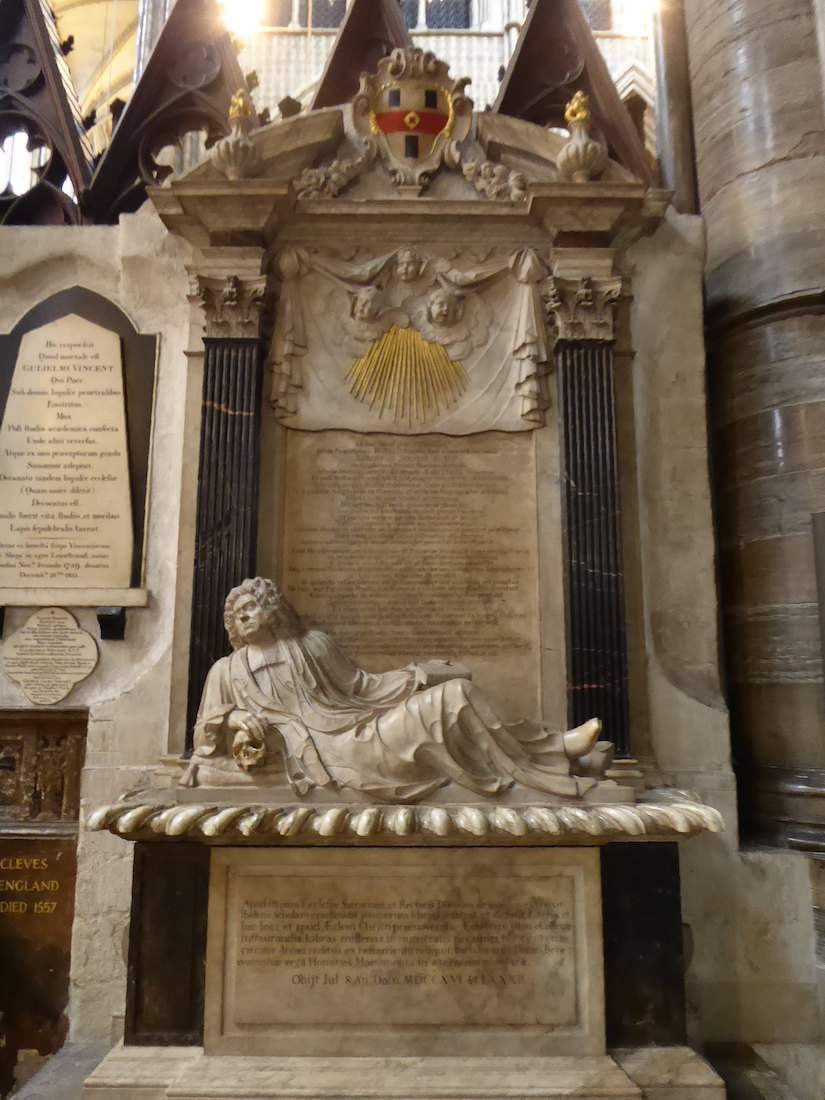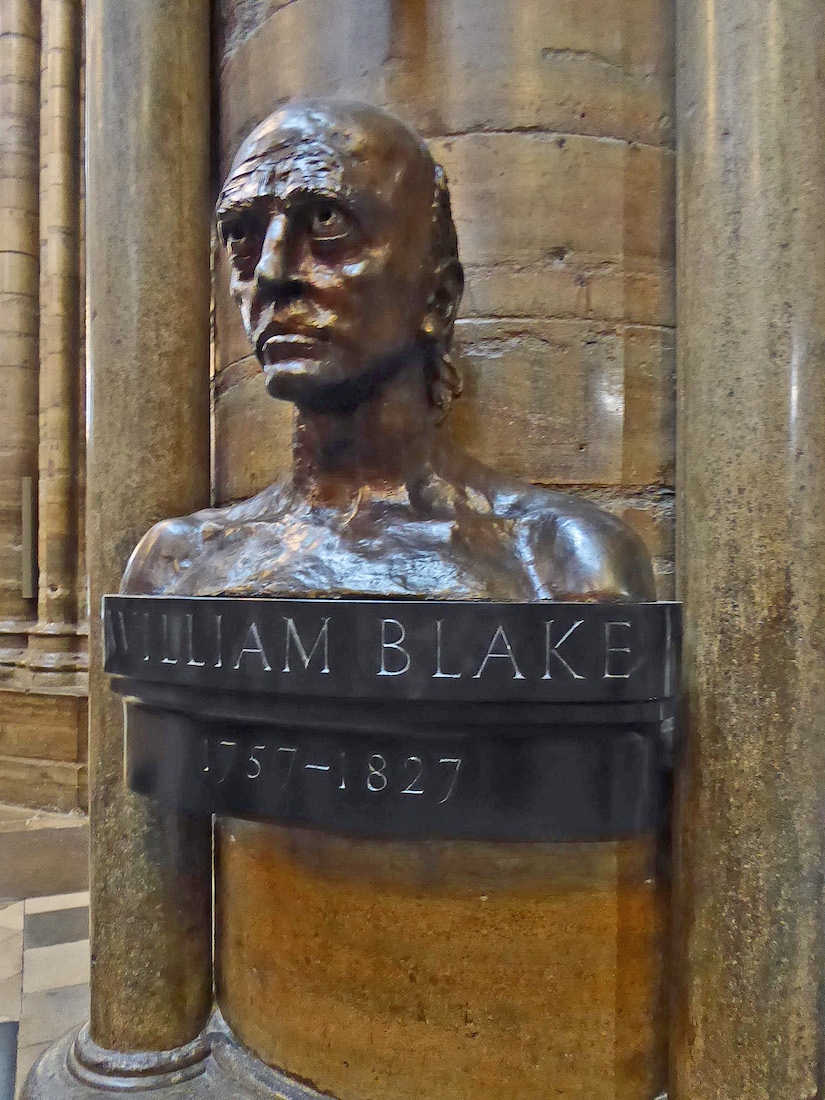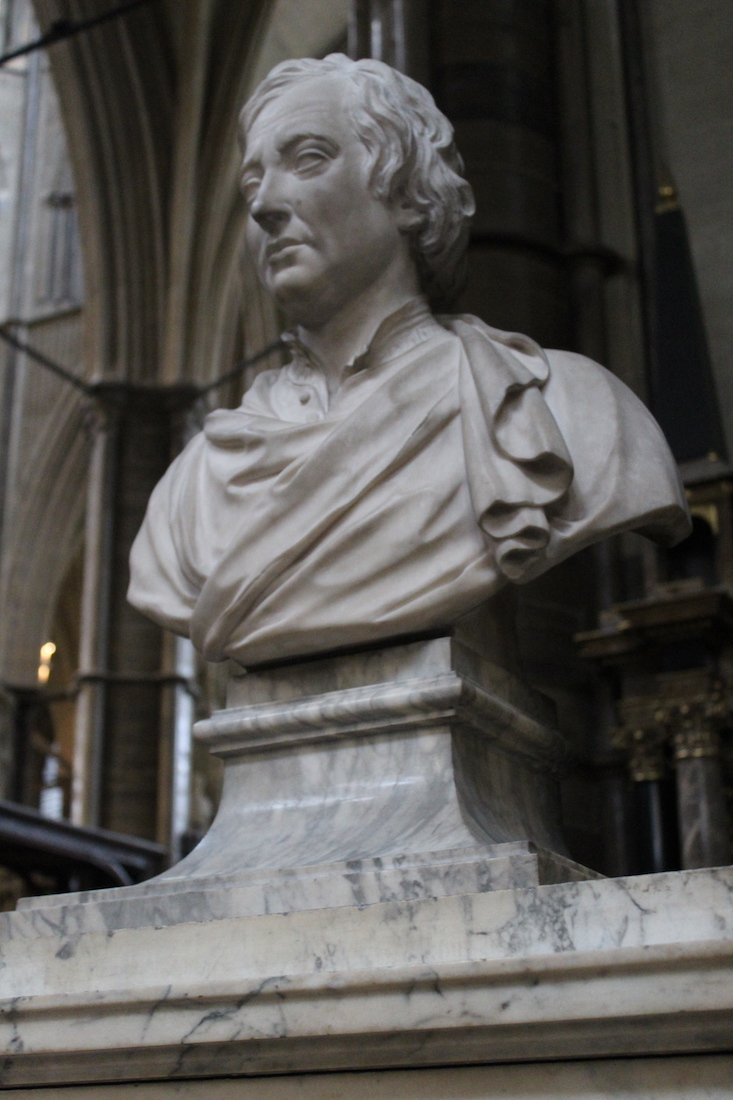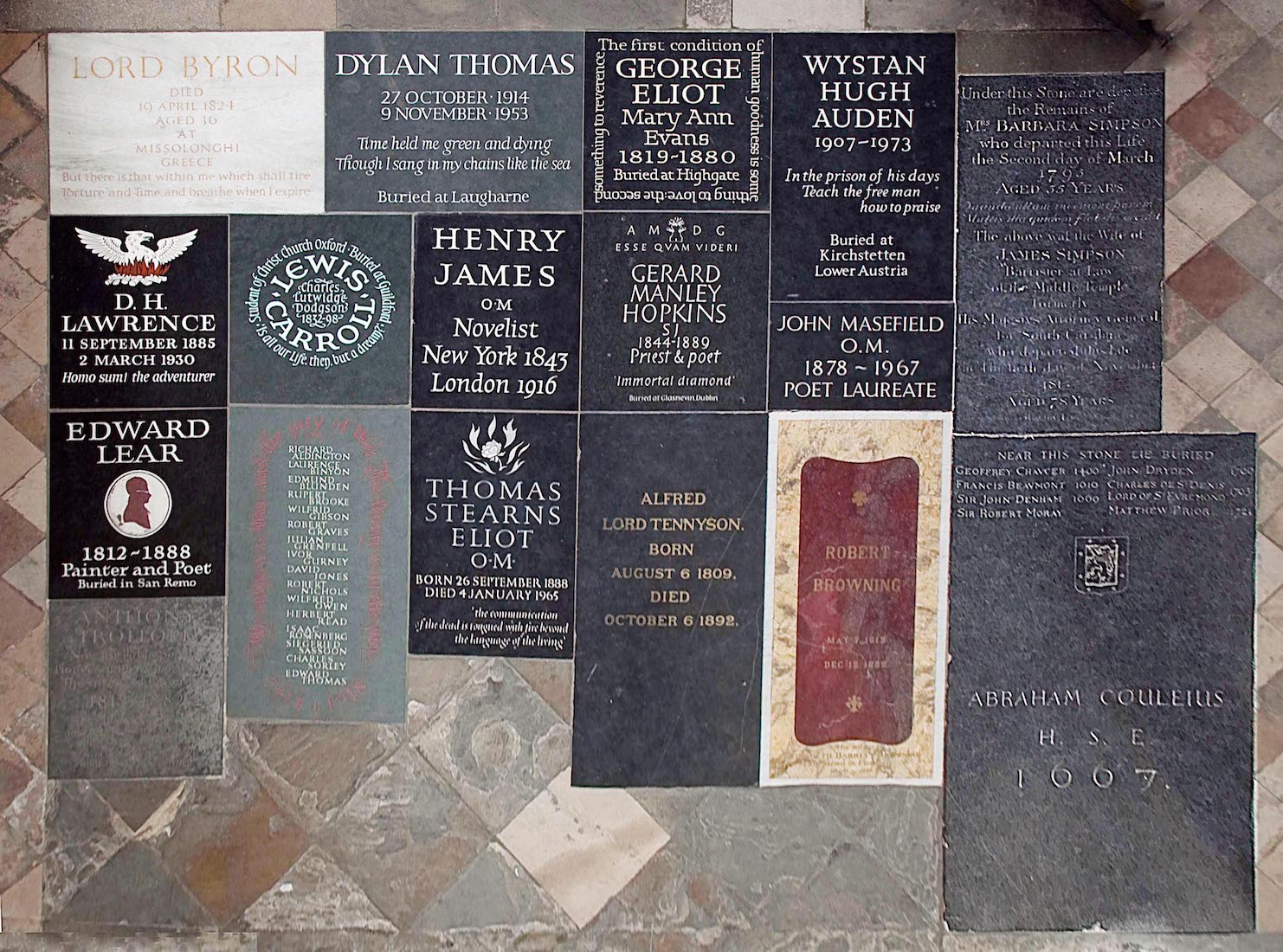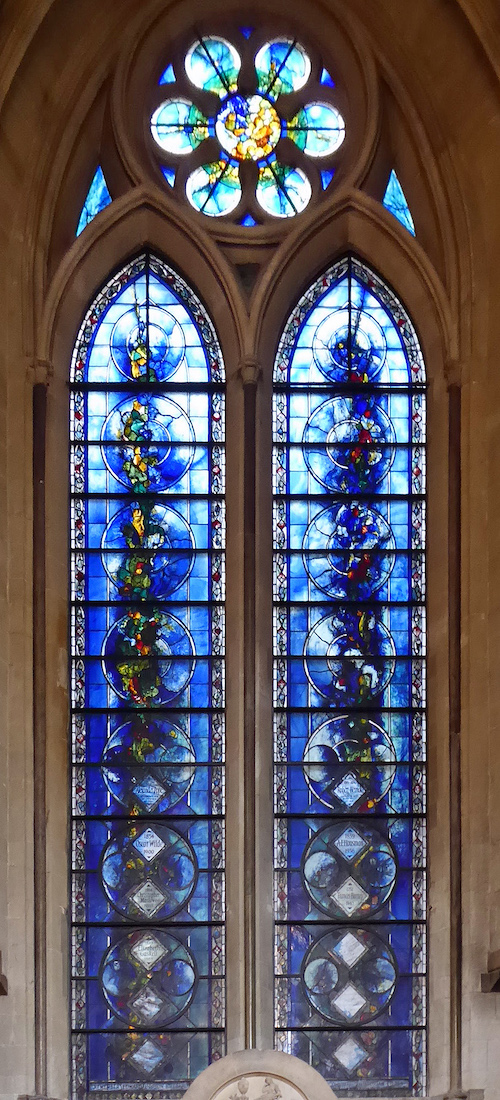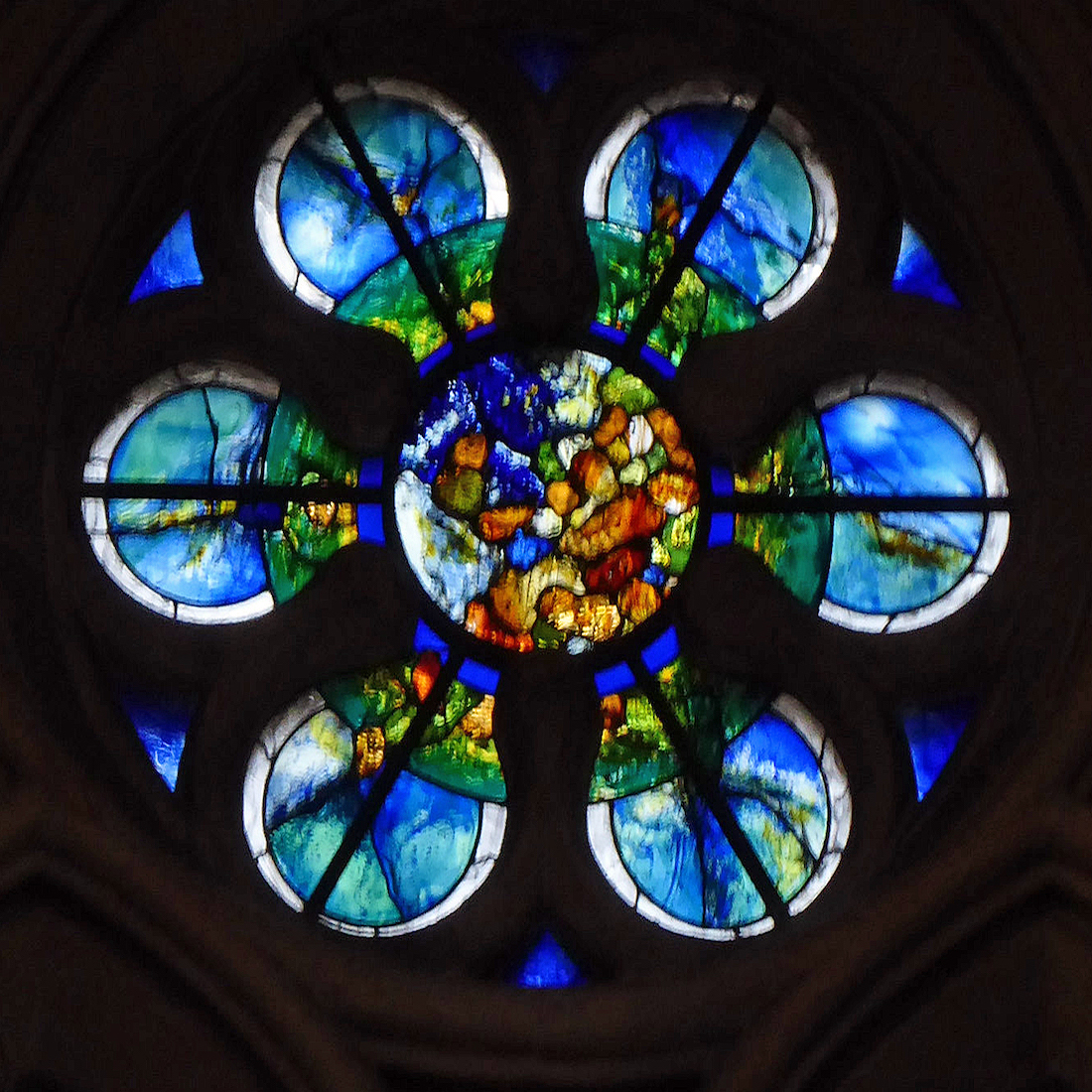E. SOUTH TRANSEPT
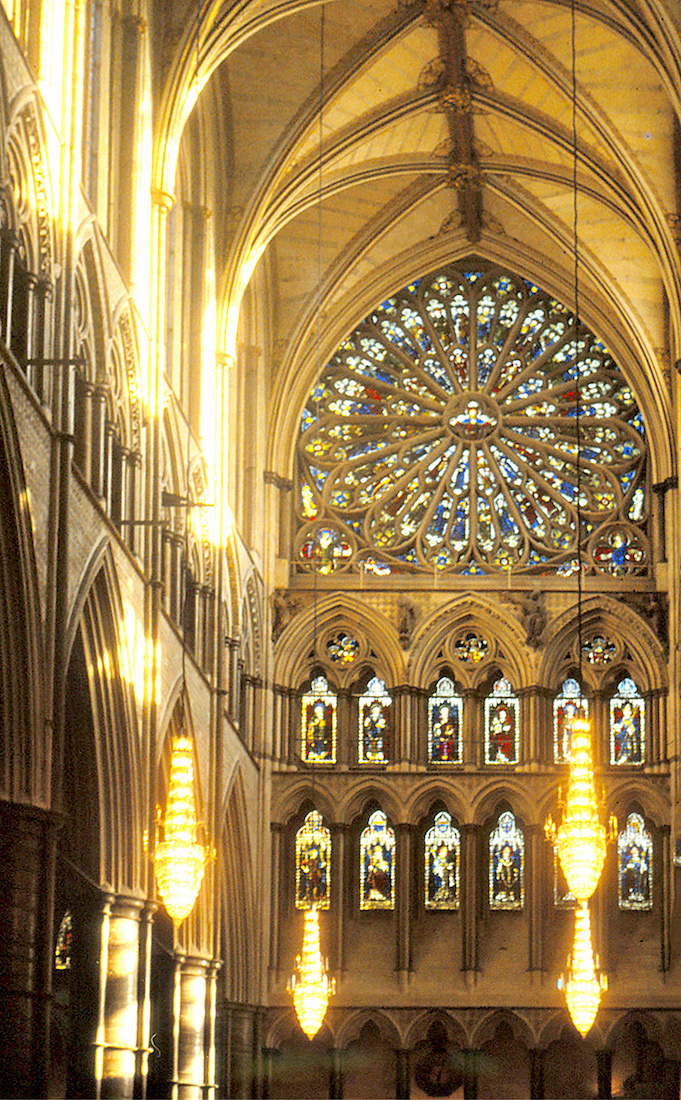
We come over the crossing to the South transept. This is famous for its ‘Poet’s Corner’ but there is much more than that. For example there is another magnificent rose window, this one with twelve lancet windows below. INDEX
E2. SOUTH ROSE WINDOW
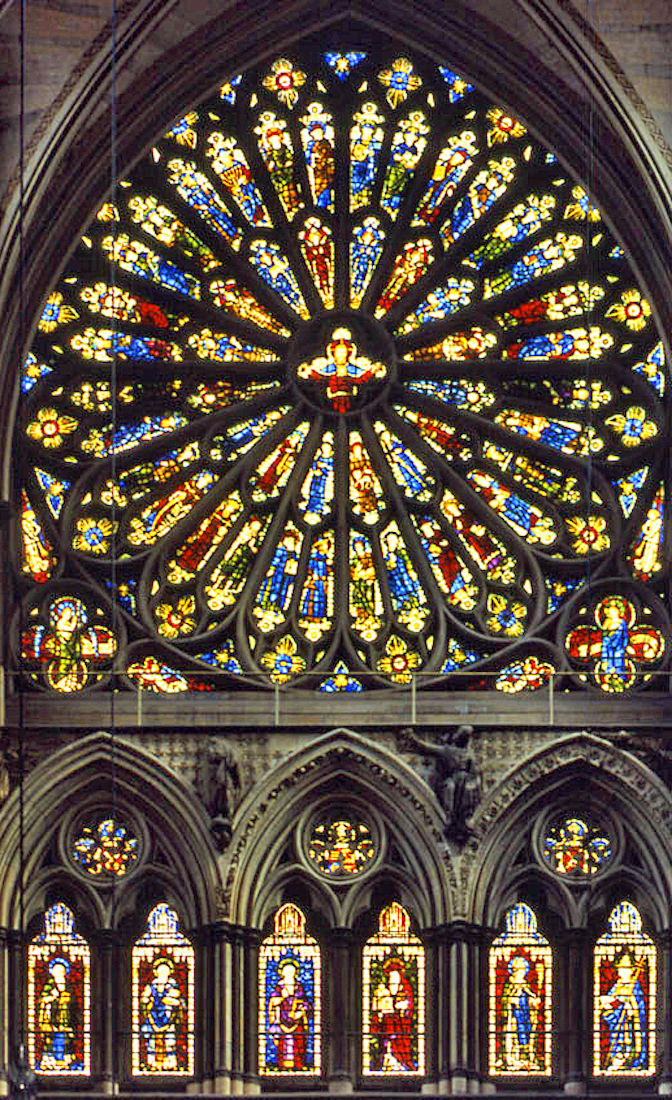
The South rose window was designed by Sir James Thornhill and depicts Christ surrounded by 16 symbolic figures of the virtues and orders of angels. The glass in this window was filled with new glass in 1902, by Burlison & Grylls, replacing some dark 19th century glass. This remake was done in memory of Hugh, 1st Duke of Westminster (1825 -1899). There are twelve lancet windows with stained glass below the rose window. [Photo Credit: Royaldds Requested]
E3. VIEW TO THE NORTH TRANSEPT AMT
If we turn around through 180° we can view the North transept with its corresponding rose. But of particular interest to us now is the wall of monuments at left. We shall investigate some of these monuments, but the wall itself is of some interest in that it appears to be ‘free standing’: the ends connect to the adjacent pillars, but the top is not connected. We shall discover more about this later.
E4. WEST BAYS 12, 13 AMT
In these West bays 11 and 12, there are twelve wall monuments, a standing column monument at left and four busts. We shall not be commenting on all of these!
E5. GARRICK MONUMENT AMT
In fact we just note the Garrick monument. This memorial is a white and grey marble monument to the famous actor David Garrick. It consists of a standing figure of the actor who holds aside curtains, as if taking a bow after a performance, and on either side are seated the figures of Tragedy and Comedy. Above Garrick’s head is a medallion portrait inscribed ‘Shakspeare’ (the then spelling of his name).
E6. SOUTHWEST CORNER MONUMENTS AMT
There are six further monuments along the West wall of Bay 14, and this brings us to the Southwest corner of the transept, with the Argyll monument on the South wall.
E7. WEST BAY 14, MONUMENTS AMT WC
On the West wall is an odd memorial to Sir Thomas Robinson (d.1777) and his wife Elizabeth, LadyLechmere (d.1739) (below) and Jenny Lind (1820 – 1887) (above). The lower inscription on behalf of Sir Thomas reads in part: ‘ this monument was erected to perpetuate his grateful sense of the pleasure he had in the conversation of an accomplished woman, a sincere friend, and an agreeable companion; with particular directions that his own bust should be placed by hers.’ •• Johanna Maria ‘Jenny’ Lind (1820 – 1887) was a Swedish opera singer, often called the ‘Swedish Nightingale’. One of the most highly regarded singers of the 19th century, she settled in England in 1855. From 1882, for some years, she was a professor of singing at the Royal College of Music in London. [Photo2 Credit: WC 14GTR]
E8. CAMPBELL AND HANDEL MONUMENTS AMT AMT
At left is a memorial to Sir Archibald Campbell (d.1791) by Joseph Wilton. The inscription reads: ‘Sir Archibald Campbell of Inverneil, Knight of the Most Honourable Order of the Bath, Major General of His Majesty's forces, Colonel of His Majesty's 74th (Highland) regiment of foot, Heretable Usher of the White Rod for Scotland, late Governor of Jamaica, afterwards Governor of Fort St George and Commander in Chief on the coast of Coromandel in the East Indies. ... ’ ••• At right is a memorial to famous composer George Frederick Handel (d.1759), by Louis Francois Roubiliac. The works that associate Handel most closely with Westminster Abbey are the four anthems written for the coronation of George II in 1727. The best known, ‘Zadok the Priest’, has been used at every coronation since then, but all four continue to be regularly performed and recorded.
E9. SOUTH WALL AND ARGYLL MONUMENT GSV AMT
Exploring the transept further, we notice the Argyll monument on the far wall at the corner at right, two painted arches on the wall at left, and next to them around the corner, the Shakespeare monument. ••• At right is a close-up of the monument to John Campbell, 2nd Duke of Argyll (d.1743) by Louis Francois Roubiliac. A life size figure of the Duke in Roman armour reclines on a sarcophagus with a figure representing History behind him. The figure is recording his name on the pyramid behind them, stopping short at ‘GR’ to indicate that the dukedom of Greenwich died with him. At floor level is a figure representing Eloquence, her right arm outstretched as she addresses the viewer. The rod and serpent which she held in her left hand is missing from the monument but is still in the Abbey collection. The other is a seated figure of Minerva.
E10. SOUTH WALL PAINTINGS AMT
There are several medieval wall paintings to the left of the transept door. The paintings depict Christ with Doubting Thomas (left) and St Christopher (right). These two paintings were in the chapel of St Blaise, a small chapel in the Southern section of the South transept which survived until the 18th century.
E11. CHARLES DICKENS WC
A small stone with a simple inscription marks the grave of Charles Dickens, famous English novelist, near the South transept door in Westminster Abbey: CHARLES DICKENS // BORN 7th FEBRUARY 1812 // DIED 9th JUNE 1870 This was at his own wish. He wrote in his will ‘that my name be inscribed in plain English letters on my tomb ... I rest my claims to the remembrance of my country upon my published works...’. [Photo Credit: WC User:Jack1956]
E12. SHAKESPEARE MONUMENT AMT
Just around the corner from the medieval paintings is this memorial wall, most famous for its central Shakespeare monument. As Shakespeare’s reputation rose, monuments began to be created in nationally significant locations. William Kent designed a statue for Poets’ Corner. The design was executed by the sculptor Peter Scheemakers and installed in 1740.
E13. LADY NOVELISTS WC WC
A number of other poets / novelists have memorials around the Shakespeare monument. Almost hidden near the base are memorials to Jane Austen and the Bronte sisters. Jane Austen was an influential novelist known as a master of comedies of manners. Her work is witty and often ironic, representing the intricacies of proper social behaviour, especially behaviours expected of young women. The Bronte sisters are Charlotte, Emily, and Anne, who were all novelists. The Brontes are recognized as key Gothic novelists, working in the dark Romantic literary movement. [Photo Credits: Wikimedia Commons JRennocks: Photo1, Photo2]
E14. BURNS AND COLERIDGE WC AMT
Also remembered on the Shakespeare wall are the famous literary figures Robert Burns and S T Coleridge. Robert Burns (1759 – 1796), also known familiarly as Rabbie Burns, was a Scottish poet and lyricist. He is widely regarded as the national poet of Scotland and celebrated worldwide. •• Samuel Taylor Coleridge was an English poet, literary critic, philosopher, and theologian who, with his friend William Wordsworth, was a founder of the Romantic Movement in England and a member of the Lake Poets. [Photo Credits: Wikimedia Commons 14GTR Photo 1; Photo2]
E15. ACROSS TO THE EASTERN BLUE WINDOW AMT
On the Eastern wall of the transept is a vivid blue window. We are going to move across to see this, crossing a floor of memorial slabs.
E16. NORTHEAST CORNER AMT
But first we check out the Northeast corner of the transept. The blue window is at right, ahead of us, Dryden stands rather incongruously in front of St Benedict’s Chapel, and between the two columns at left we see two reclining figures. The South ambulatory, which we have yet to explore, can just be glimpsed behind the central column. Notice too the dark bust of William Blake on the central column.
E17. BUSBY AND SOUTH MONUMENTS AMT AMT
There are the two reclining figures. At left is a monument to Dr Richard Busby (d.1695). Busby was Professor of Sacred Theology, Head Master of Westminster School, Installed Prebendary in the Church of Westminster, Installed Treasurer at Wells Cathedral. ••• At right is a monument to Robert South(d.1716) by Francis Bird. He was chaplain to Lord Clarendon, chancellor of Oxford university and became a prebendary, or canon, of Westminster in 1663. He travelled to Poland as chaplain to the ambassador Laurence Hyde, afterwards Earl of Rochester, and became chaplain in ordinary to Charles II. He was rector of Islip in Oxfordshire from 1678 and declined the Deanery of Westminster.
E18. BLAKE AND DRYDEN BUSTS AMT WC
We have earlier noted the positions of the busts of William Blake and John Dryden. •• The bust of William Blake (d.1827) was by Jacob Epstein (1957). Blake was an apprentice engraver who came to the Abbey to sketch many of the tombs and works of art. His earliest poems were published in 1783. The words of ‘Jerusalem’ were set to music in 1916 by Sir Charles Parry. ••• John Dryden (1631 – 1700) was Poet Laureate. His finest works, the tragedy All for Love and the political satire Absalom and Achitophel were published before he became a Roman Catholic and the poem The Hind and the Panther (1687) after his conversion. As a result of his conversion he lost his laureateship and died in poverty in Soho. [Photo2 Credit: Wikimedia Commons 14GTR]
E19. MEMORIAL SLABS: POETS’ CORNER WA
Finally we come to the base of the blue window, and this tessellation of memorial floor slabs. Many famous names here. It raises the question of how the choices for inclusion are made!
E20. EASTERN WINDOW AMT AMT
This new window was installed in Poets’ Corner in 1994 designed by Swansea-trained glass artist Graham Jones and is a beautiful’example of good contemporary design. (It may invite a comparison with Hockney’s even more recent window, but we won’t go there!) The window was designed to display commemorative lozenges in which the names of famous poets hitherto unrepresented by the Abbey's collection of memorials are added. There is an interesting rose at the top of the window.


